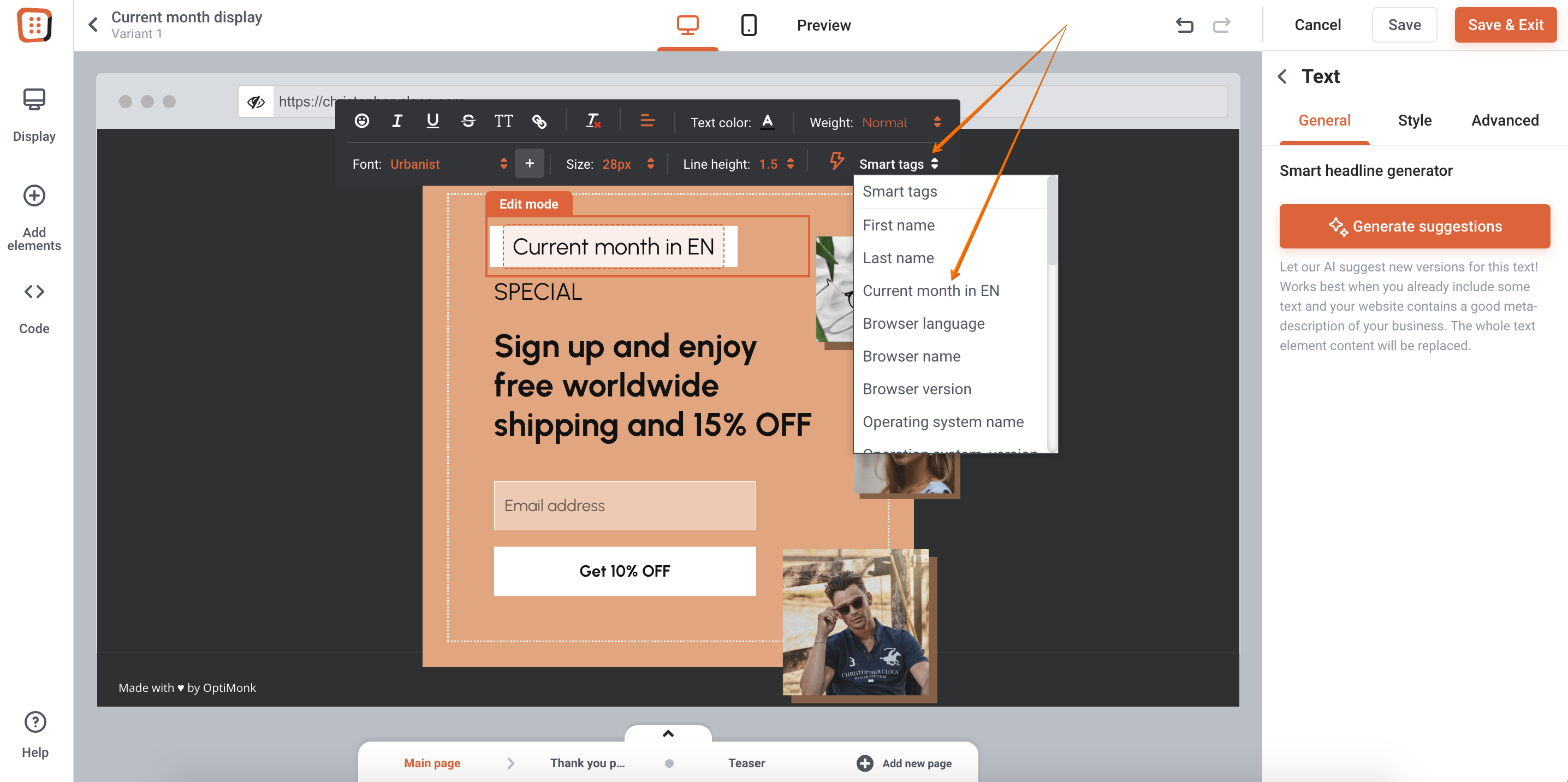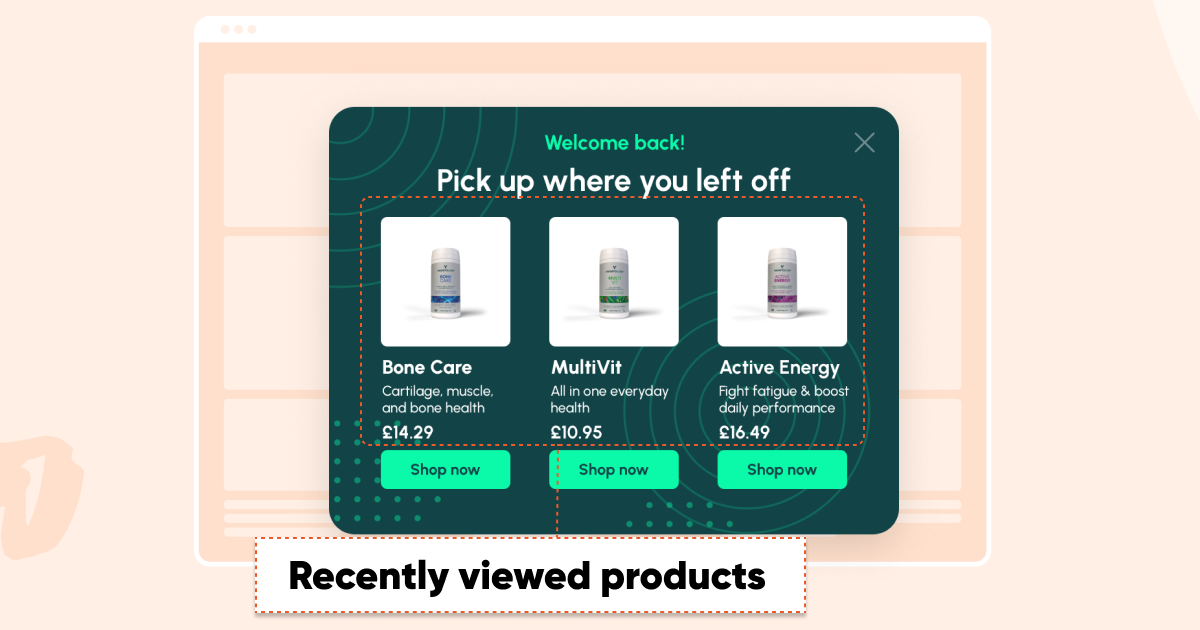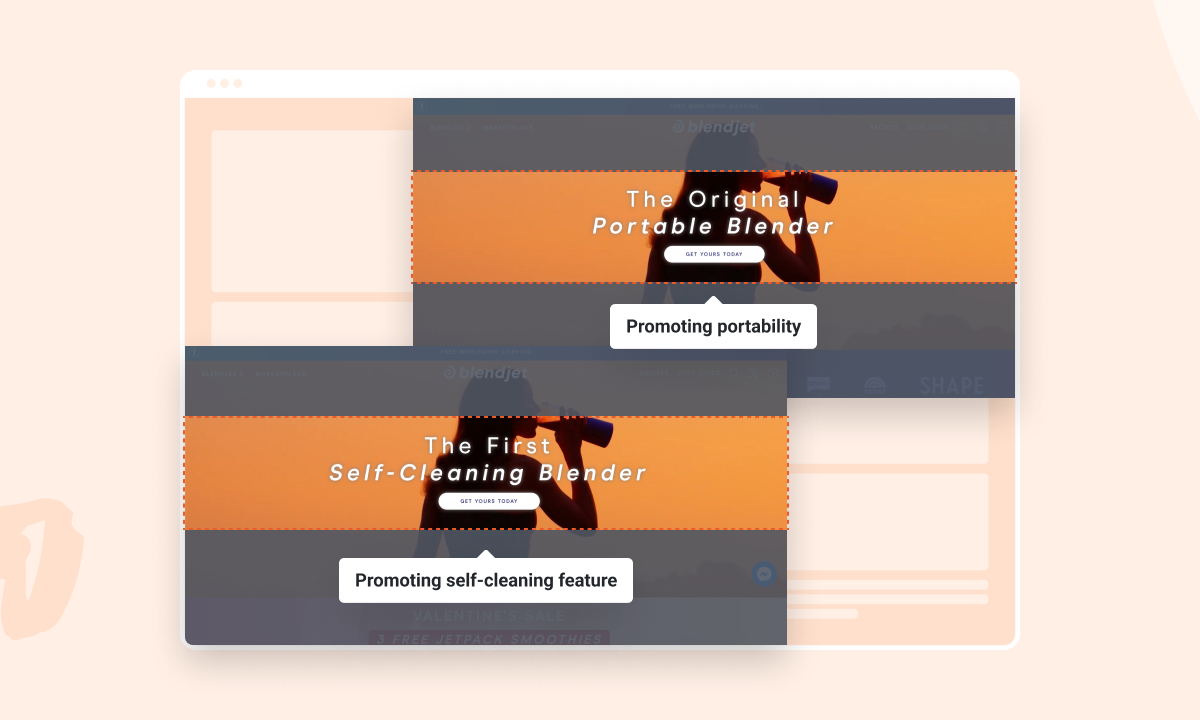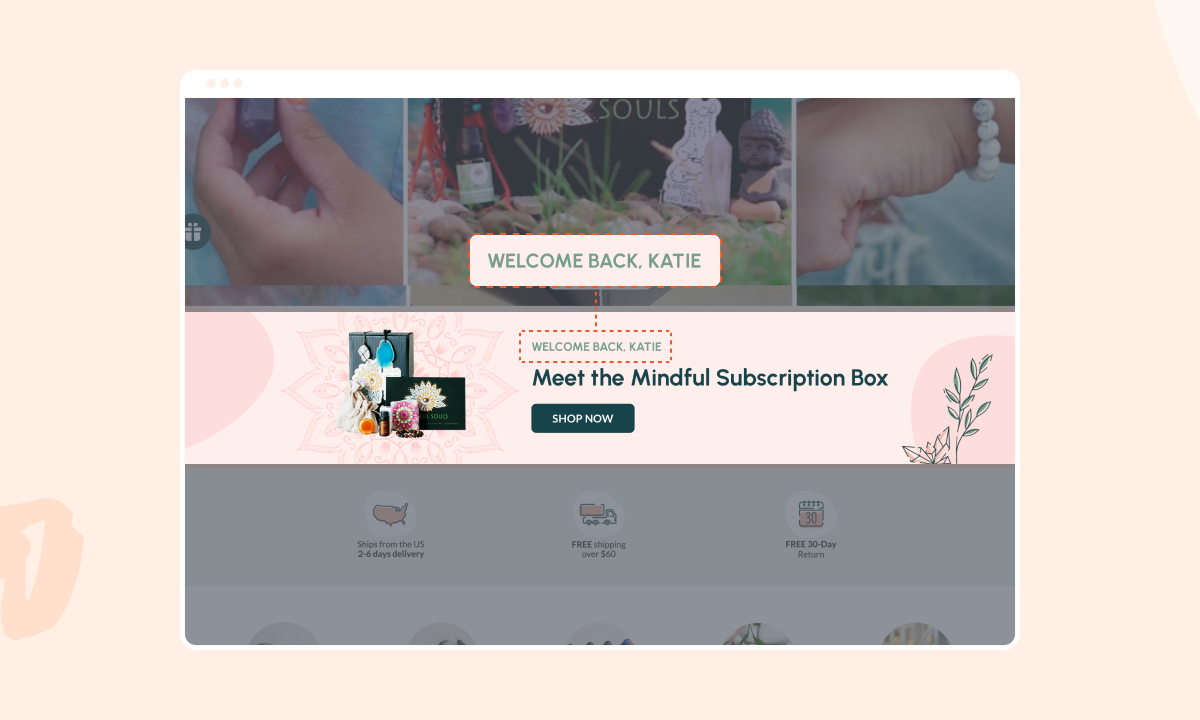- Blog
- Ecommerce Personalization Playbook: Strategies for All Levels
Ecommerce Personalization Playbook: Strategies for All Levels
-
Csaba Zajdo
- Personalization
- 6 min read
Table of Contents
The age of cheap customer acquisition is over… in 2025, you need to focus on efficiency. And that’s why website personalization is the best marketing investment you can make.
Personalizing your website is the key to unlocking a whole new level of efficiency in your sales pipeline. Imagine higher returns on your marketing activities and a boost in sales, leads, and customer loyalty. It’s all possible when you adapt your website for each individual visitor.
But I know what you’re thinking: “That sounds great and all, but how do I even get started with personalization?”.
Fear not. In this article, I’m going to go over 9 ecommerce personalization strategies, organized from starter to advanced.
And the best part? You can easily implement any of these strategies on your website with OptiMonk.
So what are you waiting for? Let’s dive in and revolutionize your marketing game with these website personalization tactics.
White belt: Starter personalization strategies
We’ll begin with three quick, smart campaigns that are tailored to the most important customer segments:
- New visitors
- Abandoning visitors
- Returning visitors
These are all evergreen campaigns, which means you can create them and then run them on autopilot. They’re easy to set up and will continue to make you money forever.
1. Encourage new visitors to subscribe to your list in a smart way
One of the most popular strategies for welcoming new visitors to a site is to offer them 10% off. Almost every ecommerce store uses a version of this basic strategy.
While this is a great tactic for incentivizing new customers to make a purchase, online shoppers see so many of these offers that they just don’t get excited about them anymore. They’re so familiar that they don’t even raise an eyebrow.
It’s important to enhance these generic offers in order to make them stand out more to your visitors and increase your conversion rates.
One of the best ways to do this is by giving these offers a seasonal spin:

Using OptiMonk’s Smart Tags feature, you can always have fresh offers without needing to update them every month!

Simply changing your welcome discounts to the “special offer of the month” will improve their efficiency and make them feel much more special.
You can learn more about this tactic by reading this guide to creating seasonal offers automatically.
2. Stop price-aware abandoners without discounting
When it comes to stopping abandonment, offering discounts is a strategy that many ecommerce stores swear by. But is this strategy equally effective for all groups of visitors?
Let’s consider an online shopper who arrived at your site from Google Shopping Ads or another price comparison site. They’ve landed directly on one of your product pages but are just about to leave. Should you offer them a discount?
We’d say that it’s better not to. Why? Because these visitors have already seen your prices in the Google Shopping Ads (and they clicked through), so price is probably not the reason that they’re bouncing.
Instead of trying to solve the wrong problem, you should try to direct their attention to a wider range of products on your site. Maybe they’ll find a product they love!

You can encourage product discovery (and decrease bounce rates at the same time) by promoting your trending products in an exit-intent popup.
You can do all this dynamically using OptiMonk. All you need to do is to create a single exit-intent popup and set it up correctly for your Google Ads traffic. Learn more here.
3. Help returning visitors continue where they left off
People rarely buy from a website on their first visit, especially when it comes to higher-ticket items. Usually, people have to take the time to research their problem, check out a variety of options, and consider their decision carefully.
But that doesn’t mean they won’t return to buy from you later!
When they do return, you want them to get right back into the swing of their shopping experience as smoothly as possible.
One great way to do that is by helping them continue where they left off last time. You can use an overlay (popup or sidemessage) to show them their previously viewed products, allowing them to continue with a single click:

If you’d like to boost your conversion rates from returning visitors, you should definitely implement a campaign like this!
All you need to do is set up a welcome message for returning visitors and show them their previously viewed products. Here’s how to set it up in more detail.
Blue belt: Intermediate personalization strategies
These next three strategies take your personalization game a step further.
At this point, it’s time to start personalizing your messaging by fine-tuning your unique selling proposition (USP), collecting zero-party data, and testing your messages against each other.
4. Optimize your landing pages by experimenting with new messages
One common reason for low conversion rates on landing pages is having an unclear or unappealing USP. It often takes a lot of time for a brand to find their most effective USP.
If you’re still not sure what type of headline will resonate best with your target audience, you should test out different versions of your USP and landing page headlines.
Here’s an example of BlendJet testing out two different value propositions using OptiMonk’s Embedded Content feature.

Click here for a step-by-step guide on how to start testing your landing pages. This will help you make data-backed decisions about what you should focus on in your USP. When your headlines lure in as many customers as possible, you’ll see your conversion rates and revenue skyrocket.
But there are many different ways you can improve your store’s performance using experimentation.
For instance, you might also start testing different list-building offers and campaign types against each other:

Once again, testing out two list-building campaigns like in the example above will tell you which strategy works best based on real data, not gut instincts. And that means you’ll be able to optimize your site with confidence.
5. Segment your visitors and collect zero-party data
Switching your welcome popup to a conversational popup will improve its conversion rate and help you gather valuable data about your visitors. When you’re able to learn what each individual user is interested in, you can enhance their experience on your site.
You can think of a conversational popup as a combination of a traditional discount welcome popup and a quiz.
First, you ask one or more questions about your visitors’ problems or what they’re looking for. Once they’ve responded, then (and only then) you request their contact details in exchange for a discount. Once they’ve signed up, you can show each new subscriber personalized recommendations based on the answers they gave in the first stage.

Conversational popups result in a better user experience, helping potential customers find products they’re interested in more quickly and easily.
When you’re able to deliver value like this to your customers, you’ll also see higher conversion rates!
Get started with these conversational popup templates:
And learn more about how to set up conversational popups here.
And, you can use the information you’ve collected to personalize further stages of the customer journey, both by tailoring your promotional emails and adapting your website content.
6. Show limited-time offers consistently throughout your site
Some ecommerce stores make the mistake of only displaying their offers on certain pages of their website, which limits the amount of visitors who will see them. You should aim to create a consistent experience across your entire site.
For example, imagine that you have a seasonal offer (like a Summer Sale or Black Friday Sale) that you’re promoting on your homepage hero banner. But what about visitors who don’t arrive on your homepage?
You can use OptiMonk’s Embedded Content to make sure that all of your visitors, even those who arrive directly on a product page, find out about your limited-time deals:

With this tactic, you’ll be able to leverage the FOMO effect by making sure that visitors are constantly seeing both your offer and the deadline while browsing.
For best results, you should use a countdown timer element and schedule the campaign in advance.
Black belt: Advanced personalization strategies
At the most advanced level of personalization, you should start thinking about how to provide a highly personalized one-to-one experience.
Here are a few tactics you might want to consider at the advanced level:
7. Personalize landing page headlines
If you’re running multiple Facebook or Instagram ads with different copy, value propositions, or designs, you can consider matching the content of your landing pages to your ads.
It makes a huge difference when your landing page headline and copy match the value proposition of each ad. Why? Because users see a landing page that reinforces the same features or value proposition that convinced them to click on the ad!
Using this strategy can go a long way toward increasing the ROI of your paid ads.

In order to personalize your landing pages, all you need to do is create a new Experience variant for each Facebook ad and personalize your landing page copy using OptiMonk’s Dynamic Content feature. Learn more here.
8. Personalize messages based on first-party data
Your website collects first-party data automatically, so you should definitely be using it to personalize your messaging.
Location information is one example of first-party data. You can improve the customer experience for international visitors by personalizing your welcome popups with the name of their country (or even the flag).

And with OptiMonk’s Smart Tags feature, it’s easy to set up. Simply adding the “Country in EN” Smart Tag to your copy will allow your campaigns to automatically update and display the name of each visitor’s country, which creates a memorable user experience.

Check out this guide to using Smart Tags for location-based personalization.
Another important piece of first-party data that you already have access to is the traffic source (where each visitor came from).
If you’re active on social media channels like Facebook, Instagram, and TikTok, you might want to personalize your messages based on where your visitors are arriving from.
This is an especially good strategy for brands that get great engagement and lots of traffic from social posts and ads.
Here’s what a campaign that’s personalized based on traffic source could look like:

As a rule of thumb, your social traffic should be more than 5% of your total traffic in order to make this strategy worth implementing. But if you do have lots of traffic coming from your social media accounts, there’s a huge opportunity.
Take a look at this guide to learn about how to use source-based targeting to personalize your messaging and boost your conversion rates.
Another version of the above strategy is personalizing messages for visitors arriving from referral/affiliate partners.

You could, for example, display the referral partner’s name in your message. This makes the offers much more special and exclusive.
OptiMonk’s URL targeting feature makes it easy to implement this strategy and increase your conversion rates by up to 50%. Here’s a step-by-step guide on how to set it up.
9. Personalize messages for returning customers
The final personalization strategy we’ll go over will help you stop treating your best customers as if they’re new users and start creating personalized experiences for them.
If your website gets lots of returning customers, you should leverage what you know about them to deliver personalized experiences. This will increase your returning customer conversion rates and keep them coming back for more.
A good place to start? Welcome your returning customers by name in your above-the-fold section. You can also present your new arrivals to them:

This kind of personalization makes your regular customers feel more connected to your brand and more willing to purchase from you again.
Here’s how you can personalize your embedded content in line with this strategy.
And don’t forget about showing personalized offers to your returning customers!
For example, when creating a segmented email campaign for one of your VIP customer segments, you can further increase the effectiveness of these campaigns by personalizing your landing pages (and even your entire website) for these visitors:

Being consistent by reminding your customers about your offer throughout your site (not just in your email) will create a more personalized customer experience. This can increase the conversion rate of customers arriving from your email messages by up to 20%.
Wrapping up
In this article, we’ve gone over 9 powerful ways to adapt your website for different audiences.
Website personalization will make your website more efficient at transforming traffic into sales.
And as you can see, you don’t need to go from zero website personalization to a fully personalized website all at once. Instead, you can slowly add personalized experiences to your website bit by bit, starting with basic strategies and proceeding to more advanced tactics.
Best of all, you can use pre-built campaigns from OptiMonk to implement any of the strategies covered above. If you haven’t made a free account yet, go make one today!
Migration has never been easier
We made switching a no-brainer with our free, white-glove onboarding service so you can get started in the blink of an eye.

What should you do next?
Thanks for reading till the end. Here are 4 ways we can help you grow your business:
Boost conversions with proven use cases
Explore our Use Case Library, filled with actionable personalization examples and step-by-step guides to unlock your website's full potential. Check out Use Case Library
Create a free OptiMonk account
Create a free OptiMonk account and easily get started with popups and conversion rate optimization. Get OptiMonk free
Get advice from a CRO expert
Schedule a personalized discovery call with one of our experts to explore how OptiMonk can help you grow your business. Book a demo
Join our weekly newsletter
Real CRO insights & marketing tips. No fluff. Straight to your inbox. Subscribe now
Csaba Zajdo
- Posted in
- Personalization
Partner with us
- © OptiMonk. All rights reserved!
- Terms of Use
- Privacy Policy
- Cookie Policy
Product updates: January Release 2025








